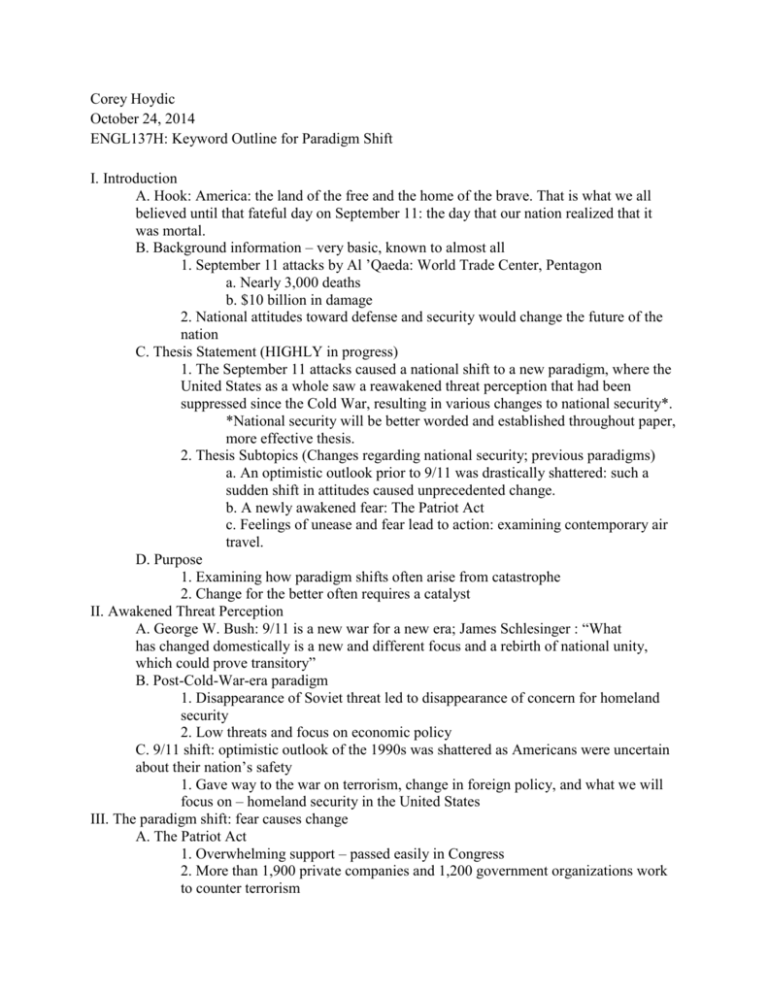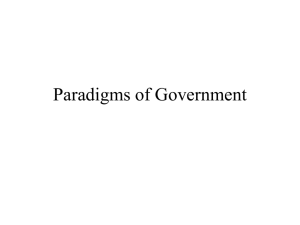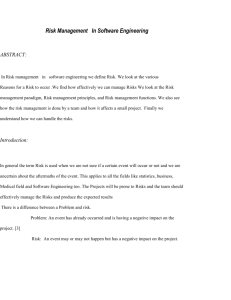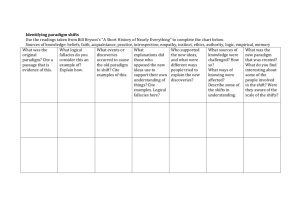Keyword Outline for Paradigm Shift
advertisement

Corey Hoydic October 24, 2014 ENGL137H: Keyword Outline for Paradigm Shift I. Introduction A. Hook: America: the land of the free and the home of the brave. That is what we all believed until that fateful day on September 11: the day that our nation realized that it was mortal. B. Background information – very basic, known to almost all 1. September 11 attacks by Al ’Qaeda: World Trade Center, Pentagon a. Nearly 3,000 deaths b. $10 billion in damage 2. National attitudes toward defense and security would change the future of the nation C. Thesis Statement (HIGHLY in progress) 1. The September 11 attacks caused a national shift to a new paradigm, where the United States as a whole saw a reawakened threat perception that had been suppressed since the Cold War, resulting in various changes to national security*. *National security will be better worded and established throughout paper, more effective thesis. 2. Thesis Subtopics (Changes regarding national security; previous paradigms) a. An optimistic outlook prior to 9/11 was drastically shattered: such a sudden shift in attitudes caused unprecedented change. b. A newly awakened fear: The Patriot Act c. Feelings of unease and fear lead to action: examining contemporary air travel. D. Purpose 1. Examining how paradigm shifts often arise from catastrophe 2. Change for the better often requires a catalyst II. Awakened Threat Perception A. George W. Bush: 9/11 is a new war for a new era; James Schlesinger : “What has changed domestically is a new and different focus and a rebirth of national unity, which could prove transitory” B. Post-Cold-War-era paradigm 1. Disappearance of Soviet threat led to disappearance of concern for homeland security 2. Low threats and focus on economic policy C. 9/11 shift: optimistic outlook of the 1990s was shattered as Americans were uncertain about their nation’s safety 1. Gave way to the war on terrorism, change in foreign policy, and what we will focus on – homeland security in the United States III. The paradigm shift: fear causes change A. The Patriot Act 1. Overwhelming support – passed easily in Congress 2. More than 1,900 private companies and 1,200 government organizations work to counter terrorism 3. U.S. Department of Homeland Security and U.S. Immigration and Naturalization Service a. Law enforcement and intelligence agencies shifted from prosecution to prevention i. Intelligence information collected – unease toward government (will elaborate later in reference to tourism, immigration, etc) b. Paradigm required the nation to realize that legal changes worked to preserve our civil liberties and freedom IV. A Case Study: Contemporary Air Travel A. We always hear how easy it was to just “hop on an airplane” back in the day 1. Aviation and Transportation Security Act – created the TSA a. Strict guidelines on passenger screening and luggage b. Contrasting attitudes of safety, while debate on right violation arises i. Modern debate: what is the price we pay for safety? 2. Airplanes changed a. Fortified cockpit doors b. Airline captains can apply to carry a gun V. Post 9/11 paradigm shift: a recap and conclusion A. Reawakened a threat perception that had been dormant for many years B. Attitudes of unease led to change in government policy and homeland security C. Commercial airfare and new means of gathering intelligence serve to both bolster security and raise new concerns and fears: are our rights violated? (I do not hit on this point much in the outline, but discussing it more in my second and third body paragraphs will give me the opportunity to bring it up in the conclusion…a point that will resonate and give the audience a chance to answer the question for themselves.) D. The land of the free and home of the brave learned that there is a price to pay for freedom 1. In the post-9/11 quest for unity and safety, we must all put faith in our country, yet let our voices be known; finding a safe medium where safety is guaranteed without violating or infringing upon our rights will serve to be a continuing challenge for the unforeseeable future









